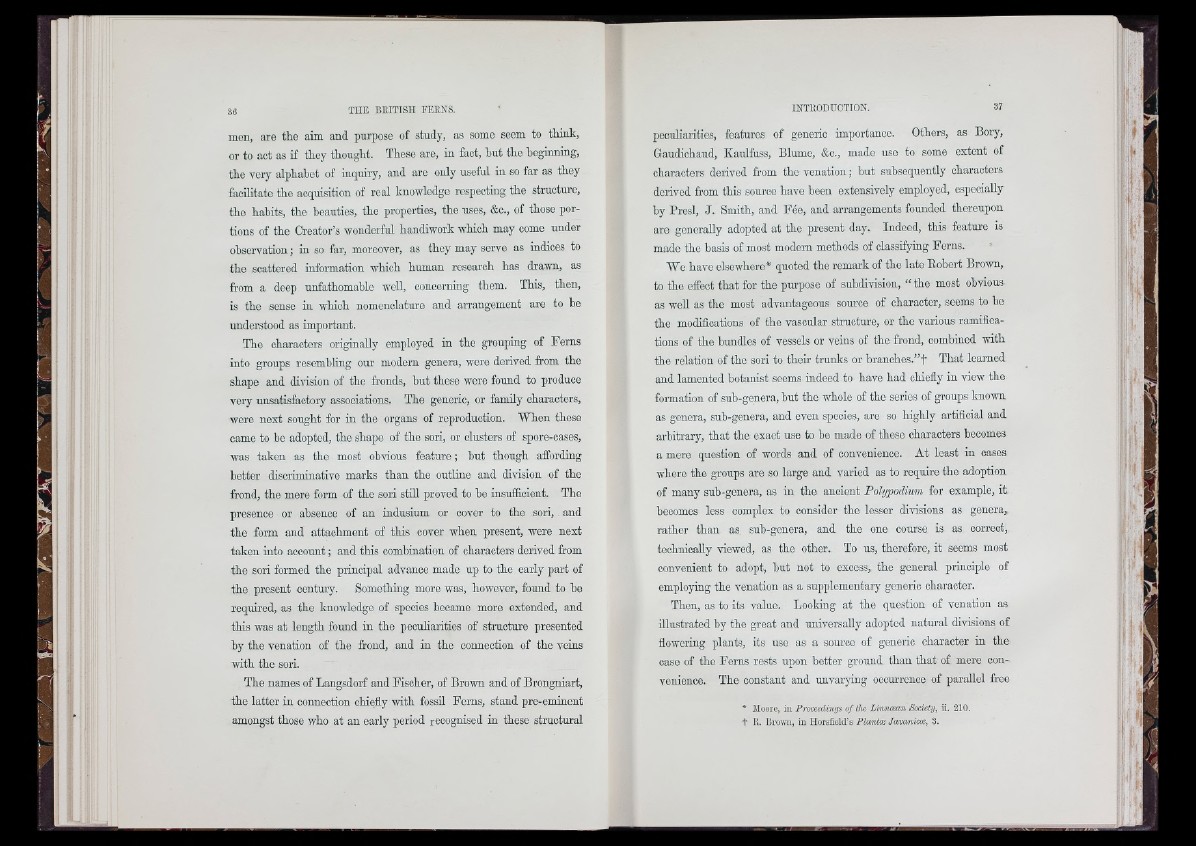
men, arc the aim and purpose of study, as some seem to think,
or to act as if they thought. These are, in fact, hut the beginning,
the very alphabet of inquiry, and are only useful in so far as they
facilitate the acquisition of real knowledge respecting the structure,
tho habits, the beauties, the properties, the uses, &c., of those portions
of tho Creator’s wonderful handiwork which may come under
observation; in so far, moreover, as they may servo as indices to
tho scattered information which human research has drawn, as
from a deep unfathomable well, concerning thorn. This, then,
is the sense in wliich nomenclature and arrangement are to he
understood as important.
The characters originally employed in the grouping of Ferns
into groups rcsomhling our modern genera, were derived from the
shape and division of the fronds, hut those wore found to produce
very unsatisfactory associations. The generic, or family characters,
were next sought for in the organs of reproduction. When these
came to bo adopted, the shape of the sori, or clusters of spore-cases,
was taken as tho most obvious feature; but though affording
better disoruninative marks than tho outline and division of the
frond, the mere form of the sori stiU proved to he insufficient. The
presence or absence of an indusium or cover to the so ri,. and
the form and attachment of this cover when present, wore next
taken into account; and this combination of characters derived from
the sori formed tho principal advance made up to the early part of
the present century. Something more was, however, found to be
required, as the knowledge of species became more extended, and
this was at length found in tho peculiarities of structure presented
by the venation of the frond, and in the connection of the veins
with the sori.
The names of Langsdorf and Fischer, of Brown and of Brongniart,
the latter in connection chiefly with fossfl. Ferns, stand pre-eminent
amongst those who at an early period recognised in these structural
peculiarities, features of gonorio importance. Others, as Bory,
Gaudiohaud, Kaulfuss, Blumo, &o., made use to some extent of
characters derived from the venation ; but subsequently characters
derived from this source have been extensively employed, especially
hy Prosl, J. Smith, and Fée, and arrangements founded thereupon
aro generally adopted at the present day. Indeed, this feature is
made the basis of most modern methods of classifying Ferns.
We have elsewhere* quoted the remark of tho late B.obcrt Brown,
to the effect that for tho purpose of subdivision, “ the most obvious
as well as the most advantageous source of character, seems to bo
the modifications of tho vascular structure, or tho various ramifications
of the bundles of vessels or veins of tbo frond, combined with
tho relation of tho sori to thoir trunks or branches.” ! That learned
and lamented botanist seems indeed to have had chiefly in view the
formation of sub-genera, hut the whole of the series of groups known
as genera, sub-genera, and even species, aro so highly artificial and
arbitrary, that tho exact use to be made of these characters becomes
a mere question of words and of convenience. At least in oases
where the groups arc so large and varied as to require the adoption
of many sub-genera, as in the ancient Polypodiuni for example, it
becomes less complex to consider the lesser divisions as genera,
rather than as sub-genera, and tho one course is as correct,
technically viewed, as tho other. To us, therefore, it seems most
convenient to adopt, but not to excess, the general principle of
employing the venation as a supplementary generic character.
Then, as to its value. Looldng at the question of venation as
illustrated by the great and universally adopted natural divisions of
flowering plants, its use as a source of generic character in the
case of the Ferns rests upon bettor ground than that of moro convcnienoe.
The constant and unvarying occurrence of parallel free
* Moore, in Proceedings o f the Linncean Society, ii. 210.
t E. Brown, in Horsiield’s Plantce Jawanicce, 3.